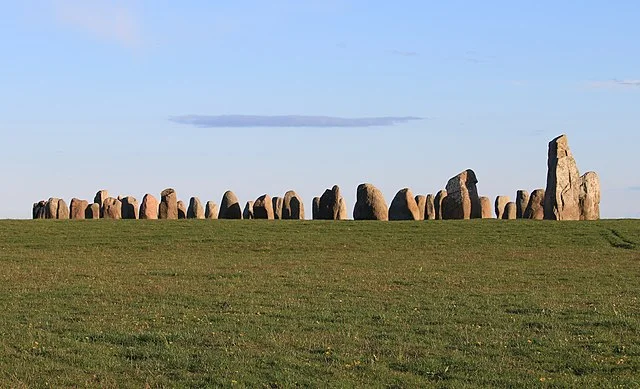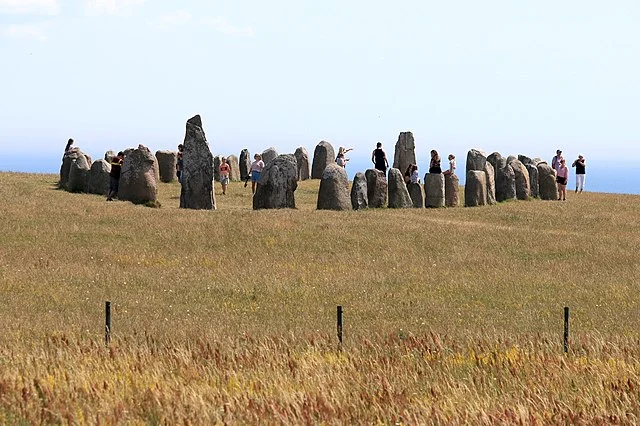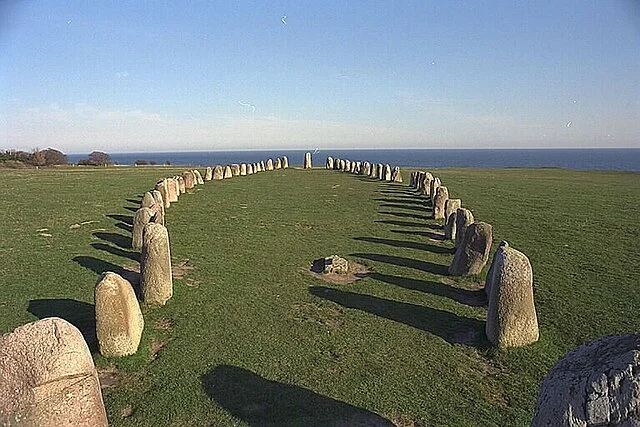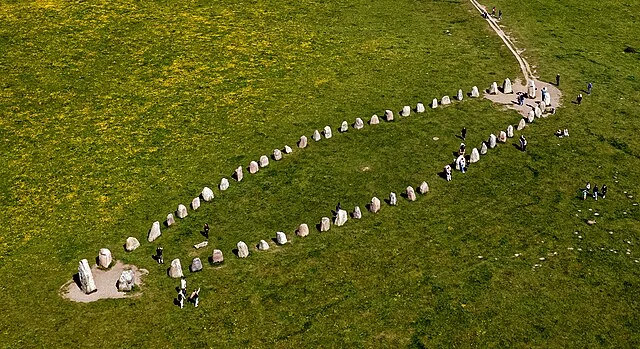Ale’s Stones (Ales stenar) is one of Sweden’s most famous ancient monuments. Located near the village of Kåseberga in southern Sweden, this megalithic structure consists of 59 large stones arranged in the shape of a ship. The stones form a 67-meter-long outline, and the site is perched on a hill overlooking the Baltic Sea. The origins, function, and exact date of the site remain subjects of scholarly debate, but it is generally agreed that Ale’s Stones date from the late Iron Age, around 500–1000 AD.
Get your dose of History via Email
Construction and Layout

Ale’s Stones follow the pattern of a stone ship, a common monument type found in the Baltic region during the Viking Age. The stone ship formations likely symbolized journeys into the afterlife, as ships played an essential role in Scandinavian culture. The structure is about 67 meters long and 19 meters wide at its center. The individual stones vary in size and shape, with the largest standing over 3 meters tall. These massive boulders are primarily sandstone, quarried from local sources.
The orientation of the monument is significant. Ale’s Stones are aligned with the setting sun during the summer solstice and the rising sun during the winter solstice. This astronomical connection suggests that the builders may have used the site for religious or ceremonial purposes linked to solar events. Similar alignments are found at other Scandinavian and European megalithic sites, which often had connections to astronomical observations.
Theories About Function

There are several theories about Ale’s Stones’ function. Some researchers argue that it was a burial site or a monument marking a sacred area. Excavations have not revealed any human remains beneath the stones, but cremations and other forms of burial common in Scandinavian Iron Age cultures could explain this absence.
Other scholars suggest Ale’s Stones served as an astronomical calendar, similar to Stonehenge. The precise alignment with the solstices supports this idea. The Vikings and other early Scandinavian people had deep connections to the sun, moon, and stars, often using them for navigation and ceremonial activities.
A less widely accepted theory posits that Ale’s Stones marked a territorial boundary or had a political function. Such monumental sites could have symbolized the power of local chieftains or served as a gathering place for important communal decisions.
Archaeological Investigations

Excavations and surveys of the site have taken place since the early 20th century. The first detailed study of Ale’s Stones was conducted by Swedish archaeologist Gustaf Hallström in the 1910s. He documented the dimensions and layout of the stones, providing the basis for future research. In the 1980s, a team led by archaeologist Göran Burenhult conducted excavations that revealed buried wooden posts, which might indicate earlier structures at the site.
Further studies have focused on dating the stones and analyzing their astronomical significance. Carbon dating from charred wood found at the site suggests construction took place around 600 AD, during the late Iron Age. However, some scholars argue that the stones could be older, possibly dating back to the Bronze Age, as no definitive evidence exists for the site’s initial use.
Preservation and Cultural Significance

Ale’s Stones remains well-preserved and is protected as a national monument under Swedish law. The Swedish National Heritage Board monitors the site and ensures its protection against erosion, vandalism, or other threats. Ale’s Stones attracts thousands of visitors annually, including both scholars and tourists. Its cultural importance continues to grow, as it provides insight into early Scandinavian society and its relationship with nature and the cosmos.
Additionally, Ale’s Stones has become part of the broader narrative of Viking and pre-Viking history, often linked to popular perceptions of the Norse people’s seafaring and spiritual traditions. While much remains to be discovered about the site, its place within Sweden’s historical landscape is well-established.
Conclusion
Ale’s Stones stand as one of Scandinavia’s most enigmatic monuments, offering a glimpse into the region’s early history. Whether a burial site, ceremonial center, or astronomical calendar, the ship-shaped monument illustrates the complexity of ancient Scandinavian cultures. Continued archaeological research will likely reveal more about its true purpose. However, the mystery surrounding Ale’s Stones makes it a significant and captivating historical landmark.
Source:

